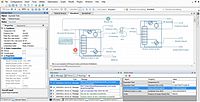Process simulation

Imagine you are playing with a toy kitchen and you want to make a cake. Making a cake involves lots of steps like measuring ingredients, mixing them together, pouring the mixture into a pan, baking it in an oven, and waiting for it to cool before decorating it.
Process simulation is like playing with a toy kitchen, but for grown-ups and serious things like making cars or manufacturing medicines. It lets engineers and scientists create a virtual version of a real production process and test it out before they actually build it.
Just like making a cake, making something like a car or medicine involves lots of steps that need to be done in a certain order. Process simulation helps figure out what that order is, and how to make each step as efficient and high-quality as possible.
For example, imagine you need to design a factory that makes cars. With process simulation, you can create a computer model of how the factory would actually work, including how robots would move, how many workers would be needed, and which machines would be used.
You can then test out different scenarios, like what would happen if you changed the order of the steps in the process, or what would happen if a machine broke down. This lets you find the most efficient and cost-effective way to build cars, without having to physically build and test the factory first.
Overall, process simulation is a powerful tool that lets people design and improve production processes in a safe and efficient way, just like playing with a toy kitchen lets you learn how to make a cake without burning down the real kitchen.
Process simulation is like playing with a toy kitchen, but for grown-ups and serious things like making cars or manufacturing medicines. It lets engineers and scientists create a virtual version of a real production process and test it out before they actually build it.
Just like making a cake, making something like a car or medicine involves lots of steps that need to be done in a certain order. Process simulation helps figure out what that order is, and how to make each step as efficient and high-quality as possible.
For example, imagine you need to design a factory that makes cars. With process simulation, you can create a computer model of how the factory would actually work, including how robots would move, how many workers would be needed, and which machines would be used.
You can then test out different scenarios, like what would happen if you changed the order of the steps in the process, or what would happen if a machine broke down. This lets you find the most efficient and cost-effective way to build cars, without having to physically build and test the factory first.
Overall, process simulation is a powerful tool that lets people design and improve production processes in a safe and efficient way, just like playing with a toy kitchen lets you learn how to make a cake without burning down the real kitchen.
Related topics others have asked about:
